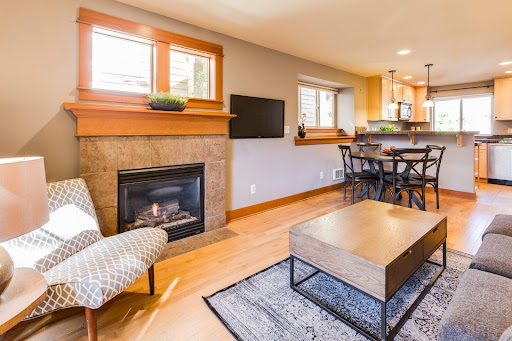
 Loading... Please wait...
Loading... Please wait...Save Money. Grow Your Own!
Fast Plain Box Shipping.
We ship to the US & Canada.
Posted on 15th Jan 2024

In recent years, the trend towards small space living has become increasingly popular, particularly in bustling urban areas. Cities like Oklahoma City are witnessing a surge in the demand for compact, efficient living spaces, driven by a diverse population seeking both simplicity and functionality in their homes. Adapting to a smaller living area, however, presents unique challenges, requiring innovative and creative solutions to make the most out of every square foot. This article explores practical and stylish ways to transform cramped quarters into cozy, multifunctional homes.
One of the keystones of small space living is multi-functional furniture. This involves selecting pieces that serve more than one purpose, thereby saving space and adding versatility to your home. Think of sofa beds that transform living rooms into guest bedrooms, extendable tables that accommodate both solo diners and dinner parties, or ottomans that double as storage units. These smart furniture choices are essential for maximizing the limited space available.
In small living spaces, bathrooms often present the biggest design challenge. Implementing space-saving designs can make these essential rooms more functional and appealing. This might include installing a corner sink, a compact shower stall, or a toilet with integrated storage. An Oklahoma City bathroom remodeling company might suggest using sliding doors to save space or wall-mounted fixtures to free up floor area. Clever design can turn even the smallest bathroom into a comfortable and stylish space.
Utilizing vertical space effectively is crucial in a small living area. This approach involves looking upwards and making use of walls and high spaces for storage and decoration. Installing wall-mounted shelves offers a place for books and decorative items without taking up floor space. Hanging planters can add a touch of greenery without cluttering windowsills. Even in smaller bathrooms, creative solutions like vertical shelving can be implemented.
Minimalist design principles can significantly make a small space feel larger and more open. This design approach focuses on simplicity and the idea of 'less is more'. By decluttering, choosing a neutral color palette, and selecting simple, streamlined furniture, a small room can be transformed into a serene and spacious area. Minimalism isn’t just a design choice; it’s a way of living that encourages efficiency and reduces overcrowding in a limited space.
Ingenious storage solutions are paramount in small space living. This involves thinking creatively about how to store belongings without causing clutter. Under-bed storage, for instance, can be a hidden haven for seasonal clothing or extra bedding. Built-in cabinets make use of underutilized spaces like alcoves, while hidden compartments can keep living spaces neat and tidy. The key is to find innovative ways to store items in a way that is both practical and aesthetically pleasing.
The strategic use of light and mirrors can work wonders in opening up a small space. Mirrors, when placed correctly, can create an illusion of depth, making rooms appear larger than they are. This is especially effective in areas with limited natural light. Similarly, ensuring that a space is well-lit, whether through natural light or well-placed artificial lighting, can make a room feel airy and spacious. The right combination of light and reflective surfaces can dramatically alter the perception of space in a small room.
Custom built-ins are a game-changer in small spaces. These features are tailored to fit specific areas of your home, maximizing every inch of available space. Built-in bookshelves that stretch to the ceiling, window seats with hidden storage, or a compact home office nook are all examples of how custom built-ins can transform dead spaces into functional areas. These solutions add unique character to your home while providing practical storage and workspaces.
The concept of transformable spaces is integral to small-space living. It involves designing areas that can easily switch functions as needed. For instance, a dining area that converts into a home office, or a living room that transforms into a guest bedroom with a Murphy bed. This flexibility allows for a dynamic use of space, adapting to different needs throughout the day or week. Furniture and design elements that can change form or function are key to making these spaces work.
The strategic use of color and decor can effectively create the illusion of more space. Bold colors, when used sparingly, can add depth to a room, while large art pieces can be focal points that draw the eye and give a sense of expansiveness. Textured fabrics and layered lighting can add richness and complexity to a small space, making it feel more open and inviting. The key is to strike the right balance between bold design and simplicity.
For homes with access to outdoor space, integrating indoor and outdoor living areas can effectively extend the living area. French doors or large windows that open up to an outdoor seating area can blur the lines between inside and outside, making the interior space feel larger. Outdoor areas can be furnished to serve as additional dining, lounging, or entertaining spaces, effectively expanding the usable area of a small home.
Living in a small space doesn't mean sacrificing style or functionality. With creative solutions, such as custom built-ins, transformable spaces, space-saving bathroom designs, thoughtful use of color and decor, and the integration of outdoor and indoor living areas, even the smallest homes can be transformed into comfortable, efficient, and attractive spaces.
These strategies not only address the challenges of limited space but also enhance the quality of living. They encourage homeowners to think innovatively and make the most of every square foot. By embracing the principles of smart design and flexibility, small spaces can be adapted to meet the evolving needs and styles of their occupants. In the end, small space living is about creating a home that is as functional and beautiful as it is cozy and unique.